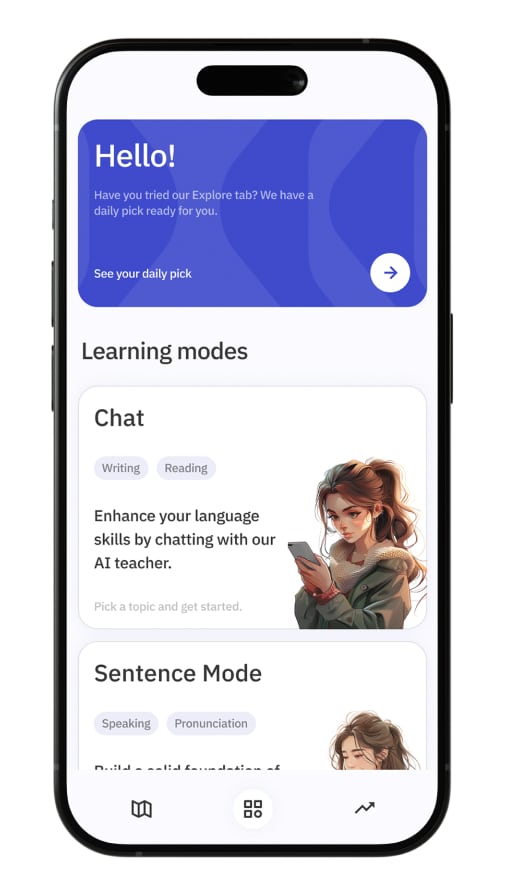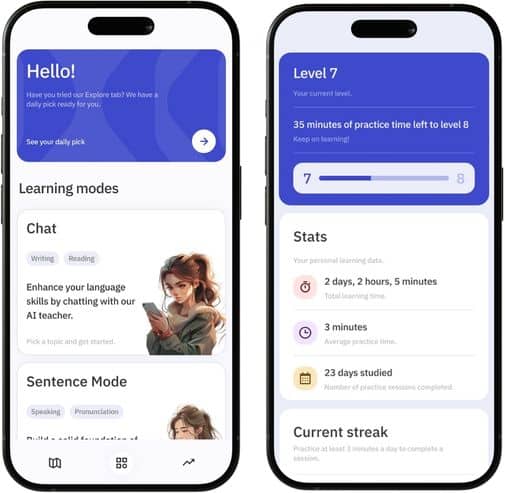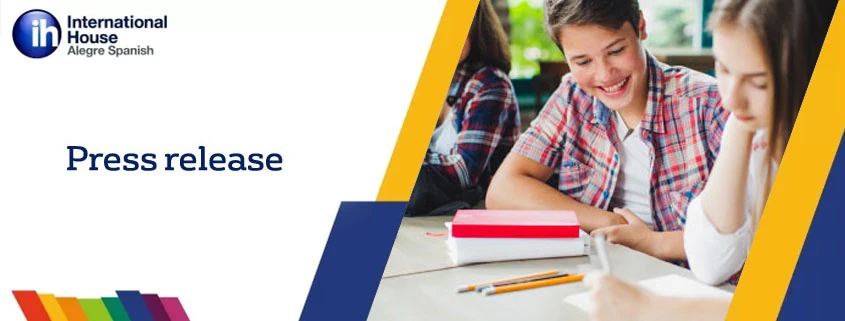

Useful Phrases to Give a Presentation in Spanish
¿has dado alguna vez una presentación en español .
Si es así, ya sabes que puede ser bastante difícil pensar en las palabras correctas cuando todos te están mirando. ¡Cuánta presión y qué nervios!
Bueno, no te preocupes, porque en esta entrada aprenderás una serie de frases en español que te ayudarán a que tus presentaciones sean más profesionales.
INTRODUCCIÓN

Al comienzo de tu presentación sería ideal seguir los siguientes pasos:
- Preséntate a ti mismo y a tu tema.
- Haz un resumen de tu exposición.
- Dile a la audiencia cómo manejarás las preguntas.
Para presentarte di tu nombre, en qué empresa trabajas y/o cuál es tu trabajo específico:
“Buenas tardes. Mi nombre es (tu nombre) y soy (tu trabajo) en (tu empresa)” .
Luego, puedes decirle a la audiencia cuál es el tema general. Aquí hay dos frases que puedes usar:
“Mi presentación es sobre…”
“Hoy me gustaría hablarte de…”
Siempre es una buena idea darle a la audiencia un resumen o una descripción general de su presentación. Recuerda dirigirte a tu público tratándoles de USTED :
“Permítanme darles una descripción general de la presentación de hoy”.
“En primer lugar voy a hablar de… (tema 1)”
“Después de eso, echaremos un vistazo a… (tema 2)”
“Entonces, consideraremos… (tema 3)”
“Y finalmente, explicaré… (tema final)”
Luego, dile a la audiencia si desea que la gente le haga preguntas en medio de la presentación o solo al final. Aquí hay una frase para cada uno:
“Por favor, siéntase libre de interrumpirme si tiene alguna pregunta”.
“Dejaré algo de tiempo para preguntas al final de la presentación”.
HACER TRANSICIONES ENTRE TEMAS
Para comenzar el primer tema, puedes usar frases como éstas:
“Me gustaría comenzar por/con… ”.
“Empecemos por… ”.
En este contexto, las palabras “comenzar” y “empezar” significan lo mismo.
Para pasar a otro tema, puede usar estas frases:
“Ahora vamos a pasar a…”
“Ahora veamos…”
“Ahora me gustaría discutir…”
“Ahora déjame pasar a…”
Notarás que todos comienzan con la palabra “ahora”: esta es una señal para tu audiencia de que estás presentando un nuevo tema.
CON REFERENCIA A DIAPOSITIVAS / GRÁFICOS

Si estás dando una presentación en PowerPoint, querrás consultar las diapositivas, que pueden mostrar imágenes, mapas, gráficos, cuadros, tablas, etc.
Aquí hay algunas frases que puedes usar:
“Esta diapositiva muestra… ”.
“Mirando esta diapositiva, podemos ver que… ”.
“Como puede ver en esta diapositiva…” .
REPITIENDO / CORRIGIENDO

¿Qué harías si dijeras algo incorrecto o confuso durante tu presentación?
Primero, ¡no te pongas nervioso/a! Los hablantes nativos de español también cometen errores durante las presentaciones, así que ¡no es el fin del mundo!.
Aquí tienes algunas frases para retomar el rumbo:
Frases para decir algo de nuevo usando diferentes palabras:
“Déjeme decirlo de otra manera”.
“Déjeme reformular eso”.
“En otras palabras…”
Frases para corregir un error:
“Lo siento, eso no es correcto. quise decir que… [hemos contratado a 15 nuevos empleados, no a 50] ”.
Disculpe + corrección con énfasis.
Por ejemplo: “La escuela fue fundada en 1999, disculpe , mil novecientos ochenta y nueve”.
Frases para describir efectos:
Por lo tanto … (usualmente usado para una conclusión lógica)
Este producto es más caro de producir. Por lo tanto, los márgenes de beneficio son más bajos.
En consecuencia … (más formal)
La empresa no obtuvo el permiso de construcción adecuado. En consecuencia, tuvimos que pagar una multa por incumplimiento.
Como resultado …
Hemos invertido en mejores equipos de seguridad y, como resultado , la cantidad de accidentes se ha reducido .
Entonces …
Los anuncios tuvieron éxito, entonces , ahora planeamos expandir el programa.
Las palabras “por lo tanto” y “en consecuencia” se usan típicamente al comienzo de una oración. “Como resultado” se puede usar al principio o al final de una oración, y la palabra “entonces” se usa típicamente en el medio de una oración.

Al final de su presentación, puede dar un breve resumen de sus puntos principales o el mensaje más importante. Aquí hay algunas frases para eso:
“En conclusión…” “Cerraré resumiendo los puntos principales”. “Permítanme recordarles brevemente lo que hemos cubierto”. Como frase final, puedes decir: “Gracias por su atención.”

Para informar a la audiencia que está listo para responder preguntas, puede decir:
“¿Alguien tiene alguna pregunta?” (generalmente se hace en una reunión/grupo más pequeño)
“Me gustaría dar paso a las preguntas ahora”. (generalmente se hace cuando se presenta a un grupo más grande)
Si no entendió la pregunta de la persona, puede decir: “Lo siento, no entendí eso, ¿podrías repetirlo?”
“Lo siento, no entiendo muy bien tu pregunta, ¿te importaría reformularla?” Las expresiones “lo siento” y “te importaría” se incluyen por cortesía.
Si la pregunta requiere información que no tienes en este momento, pero que podrías averiguar más adelante, puedes decir esto: “Esa es una pregunta interesante. En realidad, no lo sé muy bien, pero intentaré responderte más tarde con una respuesta”.
Si no puede responder la pregunta, pero alguien más puede, entonces diga: “Desafortunadamente, no soy la mejor persona para responder eso, pero puedo ponerlo en contacto con un colega mío” .
Finalmente, si la respuesta a la pregunta va a ser muy larga, puede decir: “Me temo que tomaría mucho tiempo explicarlo, pero tal vez tú y yo podamos hablar de eso más a fondo después”. Esto significa que no desea responder la pregunta de inmediato, pero está dispuesto a hablar con la persona al respecto después de la presentación.
Esto es todo por ahora.
Espero que te sea muy útil.
Deja un comentario Cancelar la respuesta
BASIC INFORMATION ON DATA PROTECTION Responsible: Teresa Buendia (Teresa Buendía) Purpose: To moderate and respond to user comments Legitimation: Consent of the interested party Recipients: Will not be sold to third parties except legal obligation. Rights: You can exercise at any time your rights of access, rectification, deletion, opposition and other legally established rights through the following e-mail: [email protected]. Additional Information: You can consult the additional and detailed information on data protection here.
Guarda mi nombre, correo electrónico y web en este navegador para la próxima vez que comente.
By making your comment you accept the Privacy Policy *
Privacy Overview

Spanish Oral Presentation Guide for Beginners
by TruFluency | Featured Spanish Blog , Learn Spanish , Spanish Presentation

The moment to show off your Spanish skills is here, and we’ll teach you how to wow your audience, coworkers, boss, or clients. The way you introduce and close your presentation can have a positive or negative effect on your audience. So, it’s normal that you get nervous about speaking in front of a crowd and communicating your ideas effectively.
Practicing oral presentations in Spanish helps you focus on pronunciation and clarity while broadening your academic, job, and business opportunities . However, what may be even more valuable is that it gives you the chance to take risks, gain confidence, and exercise persuasion in a foreign language.
If you have a presentation soon, and want to blow everyone’s mind, here is your guide to giving oral presentations in Spanish for beginners.
5 Engaging Presentation Openings
The first part of our Spanish oral presentation guide is to help you find the most engaging ways to open your speech.
1. Start with a Reflexive or Engaging Question
For example:
¿Sabían ustedes que la entonación de nuestra voz no es sonido sino emoción? (Did you know that the intonation of our voice is not sound but emotion?)
Starting with a question allows you to keep your audience attentive throughout your message.
2. Tell an Anecdote
55% of our communication stems from non-verbal language ; everything our audience reads through our expressions, mannerisms, tone, etc., while 38% of our communication is vocal and 7% is words.
Hence, the importance of telling a story at the beginning of your presentation, so your audience connects with what you are going to deliver. We are all natural communicators.
At first, you may feel shy about opening yourself to the world, but believe it or not: your story counts, your story inspires, and even more than you think.
3. Utilize Objects
Generate interest with an object that’s relevant to your message. For instance, you can follow a similar script to this one:
Esta cartera que hoy acompaña mi atuendo tiene un significado muy especial. Esta cartera ha sido elaborada, tejida y pensada por gente que cree en sus sueños. ¡Qué gusto estar el día de hoy aquí hablando con emprendedores que creen en construir!
(This purse that matches my outfit today has a very special meaning to me. This purse has been sewn, knitted, and created by people that believe in their dreams. What a pleasure to be here today talking with entrepreneurs that believe in building things!)
Utilizing resources as elements of your speech will help your public to relate and feel part of your speech. Everything has a meaning and a representation. Remember that your public will forget what you said but will always remember how you made them feel. So, make them feel welcome!
4. Statistics
Using statistical data will help give your statement a significant rational weight. Remember that statistics aren’t read, they’re interpreted. This forces you to describe exhaustive research about a topic.
This isn’t about boring your audience with numbers, it’s about using statistics as a tool to make people reflect on your message. An example of an introduction in Spanish with statistics is:
¿Sabían ustedes que el 80% de los consumidores que adquieren sus productos en línea confían más en las recomendaciones de sus amigos o familiares que de las propias empresas?
(Did you know that 80% of consumers that buy your products online trust more in the recommendations of their friends and family than on the ones of companies?)
5. Who are you?
Greet your audience. This is fundamental to bond with them. Say your name, who you are, what your topic is and why it is important to pay attention to you. Let’s put it into practice with this example:
Hoy me encuentro feliz de estar con ustedes compartiendo lo que sé. Mi nombre es Liam Jones, soy periodista y locutor de radio, y hoy quiero que aprendas a utilizar tu voz para hacerte escuchar.
(Today I am very happy to be with you sharing what I know. My name is Liam Jones. I am a journalist and radio host, and I want you to learn to use your voice to make yourself heard.)
Respect your essence, know yourself and regularly practice the above types of introduction.
Verbal and Non-Verbal Presentation Tips
The next part of our Spanish oral presentation guide is divided into verbal and non-verbal language.
Non-Verbal Language Tips
Your gestures can emphasize, substitute or contradict what you express with words.
Use open gestures, like moving your hands, stretching your arms and legs, and opening your shoulders. Additionally, avoid having objects in your way between your body and the audience, such as folders, books, and tables. Your face should be visible all the time.
Choose gestures that ease people’s understanding of your speech. For example, pointing in a direction.
Avoid fidgeting out of nervousness. For instance, touching your hair or glasses.
Distribute your gaze amongst your audience, so everybody feels included. You can divide your audience into different quadrants. Let’s say, four, and choose a person of each quadrant to “talk to”.
Volume and Intonation
Mentally “take measurements” of the room, so the volume you choose to use is enough for both people in the front row and in the back to hear you. Also, avoid monotonous intonation. Highlight with your voice the keywords of your speech.
Rhythm and Pronunciation
Slow down when you need to separate ideas, this reflects confidence and helps you recover people’s attention. Pronunciation should be clear , so be careful with mumbling sounds.
Nobody has the right to tell you how to dress, but it’s recommendable that your attire matches both your personality and the context of your presentation.
Verbal Language Tips
Order and structure.
A presentation that has order and structure is easy to follow, understand, and remember.
Organize your speech in parts. For example: importance, data, chronology, interesting bullet points, zoom in, and zoom out.
Use discourse markers; words that organize and connect ideas. Some examples are:
To Start Interventions El objetivo de esta exposición es… / Hablaré en primer lugar de… / Para comenzar… (The objective of this presentation is… / Firstly, I’ll speak about… / For starters…)
To Introduce Comments or Examples Por ejemplo… / Como es el caso de… / Recordemos, en ese sentido, que… (For example… / As is the case with… / Let’s remember, in this sense, that…)
To Structure the Discourse En primer lugar… / En segundo lugar… / Por un lado,…por otro lado… / Finalmente… (In first place… /In second place… /On the one hand…on the other hand… /Finally…)
To Resume the Subject Volviendo a lo que hemos visto al principio… / Como decía… / Señalaba que… (Going back to what we’ve seen at the beginning… /Like I was saying… / I was pointing out that…)
To Establish Logical Relationships Consecuentemente… / Eso nos demuestra que… / Deducimos, entonces… (Consequently… / That shows us that… / We deduce, then…)
To Conclude Tratemos, finalmente, el último aspecto… / En resumen,… / Para terminar… / En conclusión… (Let’s address, finally, the last aspect… / In summary… / Lastly… / In conclusion…)
You should adapt it to your audience’s knowledge, formality level, and the purpose of your presentation.
Sentences should be short and simple. Avoid the overuse of muletillas (catch phrases).
Oral Presentation Conclusions in Spanish
When you’re giving a presentation in Spanish, do not miss the chance to leave a good impression. The final part of a speech is what we remember the most. So, use it to deliver a message or briefly summarize what you want to convey. You can create a compelling conclusion with a phrase, rhetorical question, quote, or call-to-action.
En conclusión, cualquiera puede padecer de un problema de salud mental. (In conclusion, anyone can have a mental health problem.)
Si las personas más brillantes pueden padecer problemas de salud mental, ¿por qué nosotros no? (If the most brilliant people can have mental health issues, why can’t we?)
La mente es como un paracaídas, si no se abre, no sirve para nada. Muchas gracias, público oyente, por haber abierto su mente a escucharme en esta exposición. (The mind is like a parachute, if it isn’t opened, it doesn’t work. Thank you very much, listening public, for having opened your minds to listen to me in this presentation.)
Ready to be confident in your next Spanish oral presentation?
The key to giving a memorable oral presentation in Spanish is to be original, creative, and do something that’s unusual but true to your essence. Thus, you’ll make the difference.
If after reading our Spanish oral presentation guide, you think you still need help to prepare yourself for your Spanish presentation, count on our top-notch team of Spanish fluency coaches . So, don’t let fear of success hold you back, and book with one of our coaches.
Save 20% off your first month of lessons with code TF20 today!
Popular Posts
Latest blogs.

How to: Feel Comfortable Giving a Presentation in Spanish
Dear Esther,
Giving a presentation in any language can be scary, but when you have to present to people you don’t know, in a language you might not dominate (or even if you are fluent ), it can be downright terrifying. However, as an experienced presenter in Spanish—read here and here about how I did my entire degree abroad—I am here to tell you that you can do it! And it doesn’t have to be as scary as you initially think. Here are my top tips for getting through your presentations in a foreign language:
Prepare your notes:
Even if you are able to make things up as you go along in English, you should be aware that it is more difficult to control a topic in a non-native language. Therefore, take the extra hour or two to make sure you know what you want to say and how you want to say it. I know a lot of people—from all different backgrounds alike—who don’t bother to take the time to truly prepare their presentations and you can tell when they present. In addition, it will make life easier if you properly organize the content before you start preparing the presentation because then you will have you bases covered.
Pro-tip: If you’ve already prepared an assignment or paper around the topic, use this as your guide (even if it is in English). This will help you feel comfortable that you say what you have to say.
Prepare your slides:.
Once you know what you want to say and how you want to say it, you can start to prepare the visual part of your presentation (whether it be a PowerPoint, Prezi, or other tool). Make sure that the visual cues you give yourself help your words flow. My personal preference is to use a little bit of text and let your words speak for themselves (you don’t want people reading the slides instead of listening to you). Consider using keywords or photos that you can connect to your content instead of reading directly off the slide. At the same time, make sure you know what works for you and prepare accordingly.
Think about it this way: Your slides should act as an outline for what you want to say, helping your listeners follow along or jot down key points. However,if you need notes, consider bringing them along separately.
While you may feel stupid talking to yourself (maybe in front of a mirror) or practicing with your housemate, the first time through a presentation always feels harder than the second or third. If you have time to practice a time or two before you get in front of your final crowd, you can make sure you feel your way around words that you don’t feel comfortable with (potentially switching them out for others) and confirm that your presentation makes sense.

Pro-tip: if possible, try to rehearse with a native Spanish speaker who can help you figure out if what you say is clear or not. And remember that constructive criticism in your practice moments is a good option in comparison to your professor not understanding you during the presentation.
Relax and smile:.
A big part of the quality of the presentation is how comfortable you are with yourself. Even if you don’t feel like you really know the content or you are worried about presenting in front of your class, your attitude will affect the perception the audience has of your knowledge. If you are able to get up in front of everyone and act in a calm, collected way (despite the fact that you are shaking inside), that will go a long way towards a good presentation.
Try it: I found the video below that talks about about how body posture impacts our perception of a situation and I have never gone back—before every presentation you can find me in superhero pose!
It’s not the end of the world:
I just want to remind you that, at the end of the day, if your presentation is terrible it is not the end of the world. Honestly, as someone who has been there, it is commendable that you are potentially getting up in front of a whole class of native speakers to give a presentation in a language that you are only more or less comfortable with. Personally, the most important thing is to notice how you feel during the presentation and figure out ways that you can ‘do it better’ next time. Like anything, practice makes it easier, but sometimes we have to fall before we can fly.
We would love to hear about your presentation experiences while abroad. Are you a nervous presenter or are you as cool as a cucumber? Let us know!
Sincerely, Spain
P.S. I would just like you all to know that while I am a good presenter, I am not always (read almost never) comfortable when presenting, I am just good at hiding it. It has allowed me to ace presentations—not only at school but also in front of other crowds—and job interviews. Therefore, I believe it is a skill worth developing.

Related Posts

Using a Shower in Spain

Empathizing with People in Uncertain Times

What to Expect when Making Plans with Spaniards
Leave a reply cancel reply.
Your email address will not be published. Required fields are marked *
Save my name, email, and website in this browser for the next time I comment.

Which language do you want to learn?

Improve Spanish Presentation Skills

Why Improving Spanish Presentation Skills is Important

In today’s globalized world, being bilingual or multilingual can significantly enhance your professional and personal opportunities. Spanish, as the second most spoken language in the world, is particularly beneficial. Improving your Spanish presentation skills can open doors to new markets, allow you to communicate more effectively with Spanish-speaking colleagues, and improve your overall communication skills. Whether you’re a business professional, an academic, or a student, mastering Spanish presentations can set you apart from your peers.
Understanding the Basics of Spanish
Before diving into the specifics of presentation skills, it’s essential to have a strong grasp of the Spanish language. This includes vocabulary, grammar, pronunciation, and cultural nuances. Here are some fundamental aspects to consider:
Vocabulary: Building a robust vocabulary is crucial. Focus on terms relevant to your field of expertise.
Grammar: Understanding Spanish grammar rules, such as verb conjugations, sentence structures, and gender agreements, is essential for clarity and accuracy.
Pronunciation: Proper pronunciation ensures that your audience understands you. Practice common sounds that differ from English.
Culture: Being aware of cultural differences can help you tailor your presentations to resonate better with your audience.
Crafting a Compelling Introduction
The introduction of your presentation sets the tone and grabs your audience’s attention. Here are some tips to craft a compelling introduction in Spanish:
Start with a Greeting: Use formal greetings such as “Buenos días” (Good morning) or “Buenas tardes” (Good afternoon) to show respect.
Introduce Yourself: Provide a brief introduction about yourself. For example, “Me llamo [Your Name] y soy [Your Position] en [Your Company].”
State the Purpose: Clearly state the purpose of your presentation. For example, “Hoy voy a hablar sobre [Topic].”
Engage Your Audience: Use a question or a startling fact to engage your audience. For example, “¿Sabían que más del 20% de la población mundial habla español?”
Structuring Your Presentation
A well-structured presentation is easier to follow and more engaging. Here’s how to structure your Spanish presentation effectively:
Introduction: As discussed, start with a greeting, self-introduction, and purpose.
Main Points: Divide your content into three to five main points. Use clear and concise language.
Supporting Information: Provide examples, statistics, and anecdotes to support your main points.
Transitions: Use transitional phrases to move smoothly from one point to the next. For example, “Además,” (Furthermore), “Por otro lado,” (On the other hand), etc.
Conclusion: Summarize your main points and provide a clear call to action.
Using Visual Aids Effectively
Visual aids can enhance your presentation and help convey your message more effectively. Here are some tips for using visual aids in a Spanish presentation:
Slides: Use slides to highlight key points. Ensure that the text is in Spanish and is easy to read.
Images: Use relevant images to illustrate your points. Ensure that they are culturally appropriate.
Graphs and Charts: Use graphs and charts to present data. Label them in Spanish and explain their significance.
Videos: Incorporate short videos to add variety to your presentation. Make sure they are in Spanish or have Spanish subtitles.
Mastering Public Speaking Skills
Effective public speaking skills are essential for delivering a successful presentation. Here are some tips to improve your public speaking skills in Spanish:
Practice: Practice your presentation multiple times. Familiarize yourself with the content to build confidence.
Body Language: Use positive body language. Maintain eye contact, use hand gestures, and stand confidently.
Voice Modulation: Vary your tone and pace to keep your audience engaged. Avoid speaking in a monotone.
Pronunciation: Pay attention to pronunciation. Use language learning apps or work with a tutor to improve your pronunciation.
Audience Interaction: Engage with your audience by asking questions and encouraging participation.
Handling Q&A Sessions
Handling Q&A sessions effectively can enhance your credibility and leave a lasting impression. Here are some tips for managing Q&A sessions in Spanish:
Anticipate Questions: Think about potential questions your audience may ask and prepare answers in advance.
Listen Carefully: Listen to the questions carefully. If you don’t understand, politely ask for clarification.
Respond Clearly: Provide clear and concise answers. Use simple language to ensure understanding.
Stay Calm: Stay calm and composed, even if faced with challenging questions. Take a moment to think before responding.
Thank the Questioner: Thank the person for their question. For example, “Gracias por tu pregunta.”
Incorporating Cultural Sensitivity
Being culturally sensitive can make a significant difference in how your presentation is received. Here are some tips to incorporate cultural sensitivity into your Spanish presentations:
Respect Formality: In many Spanish-speaking cultures, formality is important. Use formal language and titles when addressing your audience.
Avoid Stereotypes: Avoid using stereotypes or making assumptions about your audience.
Understand Cultural Nuances: Be aware of cultural nuances, such as gestures, expressions, and customs.
Use Appropriate Humor: Humor can be a great way to engage your audience, but make sure it is culturally appropriate and respectful.
Leveraging Technology for Practice
Technology can be a valuable tool for improving your Spanish presentation skills. Here are some ways to leverage technology:
Language Learning Apps: Use apps like Duolingo or Babbel to improve your Spanish vocabulary and grammar.
Speech Recognition Software: Use speech recognition software to practice pronunciation and receive feedback.
Presentation Software: Use presentation software like PowerPoint or Prezi to create visually appealing slides.
Online Courses: Enroll in online courses focused on Spanish language and presentation skills.
Virtual Reality: Use virtual reality tools to simulate presentation scenarios and practice in a realistic environment.
Receiving and Incorporating Feedback
Receiving feedback is crucial for continuous improvement. Here’s how to receive and incorporate feedback effectively:
Seek Feedback: Ask colleagues, mentors, or language partners to review your presentation and provide feedback.
Be Open-Minded: Be open to constructive criticism. View it as an opportunity to improve.
Analyze Feedback: Analyze the feedback and identify areas for improvement.
Implement Changes: Make necessary changes based on the feedback received.
Practice Again: Practice the revised presentation to ensure that the changes have improved your delivery.
Joining Spanish-Speaking Groups and Communities
Joining Spanish-speaking groups and communities can provide valuable practice opportunities and support. Here’s how to get started:
Language Exchange Programs: Participate in language exchange programs to practice Spanish with native speakers.
Professional Organizations: Join professional organizations related to your field that have a Spanish-speaking network.
Online Communities: Join online communities and forums where you can interact with Spanish speakers.
Meetup Groups: Attend local meetup groups for Spanish learners and speakers.
Cultural Events: Participate in cultural events and activities to immerse yourself in the language and culture.
Continuous Improvement and Lifelong Learning
Improving your Spanish presentation skills is an ongoing process. Here are some tips for continuous improvement and lifelong learning:
Set Goals: Set specific, achievable goals for your language and presentation skills.
Stay Consistent: Practice consistently. Dedicate time each day or week to practice.
Expand Vocabulary: Continuously expand your vocabulary by reading, listening to, and speaking Spanish.
Seek New Opportunities: Look for new opportunities to present in Spanish, such as conferences, webinars, or workshops.
Reflect on Progress: Regularly reflect on your progress and identify areas for improvement.
Improving your Spanish presentation skills can significantly enhance your professional and personal opportunities. By understanding the basics of the language, crafting a compelling introduction, structuring your presentation effectively, using visual aids, mastering public speaking skills, handling Q&A sessions, incorporating cultural sensitivity, leveraging technology, receiving feedback, joining Spanish-speaking groups, and committing to continuous improvement, you can become a confident and effective presenter in Spanish. Remember, practice and persistence are key to mastering any skill. Start today, and watch your Spanish presentation skills soar.
Learn a Language With AI 5x Faster

Talkpal is AI-powered language tutor. Learn 57+ languages 5x faster with revolutionary technology.
LEARN LANGUAGES FASTER WITH AI
Learn 5x faster.

Home Page » Post
« next article: classroom activities for spanish class » previous article: a movie game for spanish class, thursday, march 6, 2014 (read 1626 times), how to give a spanish presentation of an author.
When I was asked this question I was reminded of the fact that while the answer may seem quite simple to those of us who are used to putting together these types of events, it may not be so simple for someone who has never done one before.
Let’s look at this one step at a time. Firstly, a presentation should get and maintain an audience’s attention. It should be based on the selected author, in a way that most audience members will find attractive. Also keep in mind that there are a number of different types of media formats available that you can use to give a presentation. You could for example hang a sign on the wall displaying relevant details about the author, which involves some research and a little writing on your part looking for images and biographical information and creating short texts (stay as brief as possible). Another possibility is to give a presentation which you could prepare on the computer using tools such as Power Point or Prezi, and you could add sound or even video files. You could also give a lecture on the author, using images and/or texts… as a Spanish teacher , this last option is the one I like to have students do in class, because it forces them to verbally express what they’ve learned about the person they’re giving the presentation on, although one problem that often arises is the fear that some people have about public speaking.
Presentations in Spanish
When collecting information in preparation for the event, it’s important, fundamental rather, to compare information you’ve found with other sources, since not everything on the internet is necessarily accurate. Make sure that your explanation of the author is as accurate as possible. Students who give in to the temptation to “copy and paste” information they’ve found online are later faced with a problem when giving their presentations: the vocabulary used does not coincide with the student’s usual “style”, and the words clearly “sound awkward”. That’s why I always advise students to avoid copying (although it’s of course the easiest method) and encourage them to instead paraphrase, putting what they read into their own words. It involves a bit more effort, but the final result is infinitely better than when students simply parrot someone else’s text, texts they sometimes don’t even completely understand.
If you’d like to give a biographical overview of the author, remember that the excessive use of dates and figures can end up overwhelming audiences. I always recommend to students that they “sacrifice” a bit of the accuracy that dates may provide opting instead for linking phrases like “cinco años después”, “a los siete meses...”, etc. reserving specific dates for particularly significant events either related to the person’s life or the historical context.
To give a presentation that audiences will find interesting from the very beginning, I also recommend preparing a general introduction about the author’s identity, their type of work, and the scope of their influence both geographically and historically. Afterwards, offer a short summary of two or three facts related to the author’s work or life, keeping it simple, and then launch into the main part of the presentation.
It’s important for students to remember that if they don’t “believe” what they’re saying, it’ll be impossible to expect other people to believe it. They should also remember that the idea is not to accumulate piles of information, that’s what encyclopedias are for. The goal of every presentation should be to get listeners interested in the person being talked about in a way that inspires them to want to find out more about that person on their own.
Remember what they say: “lo bueno, si (es) breve, (es) dos veces bueno”.
Keywords : spanish class,spanish classes,spanish teacher,presentation in spanish,spanish presentation
« Next Article: Classroom Activities for Spanish Class
» previous article: a movie game for spanish class.
Study Spanish abroad! Request more information.

Prepare a Spanish presentation with our Spanish lessons
- April 7, 2021

Prepare yourself with our Spanish courses to master the language and give a successful Spanish presentation.
Speaking a foreign language in front of a crowd can make you nervous, especially when the Spanish presentation is in front of native speakers. We recommend you to prepare yourself with Spanish courses until you complete your language training and reach a high level. In addition to having the language skills, it is important to show confidence, follow the structure of the information and speak clearly so that the audience understands the topic of your Spanish presentation.
Get all the tools of the Spanish language in one of the best Spanish schools in Cancun . Now, you can increase your language skills with Spanish online Cancun and the following tips for structuring a professional Spanish presentation.
How to prepare a Spanish presentation?
It is essential to structure a framework for your Spanish presentation where you will apply the knowledge and practice from your Spanish lessons . According to public speaking experts, it is recommended to prepare a conference in 3 steps:
- Open with something personal to capture the attention of your audience and announce what the presentation will be about.
- Name three important points and develop them with a story, examples, experience, etc.
- Summarize the key points briefly and concisely, mentioning the personal or audience impact.
The structure of a Spanish presentation is delimited by three phases: introduction, development and conclusion. Preparation is the key so you will need to study a presentation, we recommend you to learn the first 30 seconds verbatim, remember that it is important to have an interesting introduction to capture the audience’s attention from the beginning.
During the development incorporate information with multimedia material and the content that is in another language translate it or add subtitles in Spanish.
Learn Spanish in Mexico City
Key phrases for your Spanish presentation
During Spanish lessons you will learn how to communicate effectively in Spanish by developing the skills of reading, listening, writing and speaking in Spanish. Each is an integral part of mastering the language, but we will focus on the last one: speaking. Here are some useful phrases to use during your Spanish presentation:
Phrases to introduce your presentation
- ¡Buenos días/ tardes /noches a todos!
- Bienvenidos a la presentación acerca de…
- Soy ______ de la compañía ____ y el día de hoy les presentaré el tema…
- Mi nombre es______ y hablaré sobre ______.
- Las preguntas al público son una forma de llamar la atención de la audiencia, por lo que son una herramienta interesante y empática que sirve como una introducción ideal a presentaciones en español exitosas.
Spanish schools in Mexico
Phrases for the development of your conference in Spanish
During the development of the Spanish presentation it is important to pay attention to the correct pronunciation of the words, as well as the tone, rhythm and pauses. Remember that you can practice these aspects in Spanish courses to improve your Spanish speaking skills.
- Establish contact with the audience
To increase audience interest and engagement, it is important to establish contact with your audience. Use interactive elements such as polls to get them involved and express themselves on the topic, here are some examples. We remind you that you can learn Spanish while living an incredible experience in Mexico or at the Spanish school Bogota . You choose the school, we make sure you learn Spanish in an attractive way.
- Por favor levanten la mano si alguna vez ______…
- Alguien ha pensado en______?
- Por favor pregunten cualquier duda o tema.
- Comparando _____con_____, podemos notar que…
- Claramente, ______ tiene más sentido que______…
- Mientras que la Opción A es______, Option B se refiere a…
- Primeramente ______, en segundo lugar______…
- En la siguiente diapositiva…
- Asimismo, es importante mencionar que…
- Ahora pasaremos al siguiente tema…
- Preparé un video al respecto…
- Esta imagen explica perfectamente el concepto…
- Pongan atención en el video/imagen en donde …
- El promedio es…
- Los resultados demuestran que…
- De acuerdo con este párrafo, la atención debe de estar en…
- I want to stress the importance of…
- This is of high significance because…
- Moreover, it has to be said that…
Best Spanish school in Cancun
Finish your Spanish presentation successfully
In order to close your Spanish presentation correctly, here are some phrases to put your Spanish lessons into practice.
- En conclusión, podemos decir que…
- En resumen, los puntos principales son…
- Teniendo en cuenta los aspectos mencionados, podemos concluir que …
- Fue un honor estar con ustedes el día de hoy.
- Gracias por su tiempo y atención.
- Gracias por asistir al evento el día de hoy.
Remember to adapt body language to the presentation and practice in Spanish classes . Preparing a professional Spanish presentation or for personal purposes is probably one of the tests or objectives you will have when studying the language. Prepare yourself with Spanish lessons to develop your language skills and obtain an international Spanish certificate.
Enroll in one of the most important Spanish schools in Mexico and LATAM to live a language experience!

International House Riviera Maya is now a part of IALC!

Keys to converse in Spanish

Practice activities to learn the Spanish language

Basic Spanish skills

Comparative degrees of Spanish adjectives

- Luxury Experience
Our Destinations
- Mexico City
- Riviera Maya
Get personalized information of our services.
Copyright ©IH Mexico | All rights reserved

Specialty Spanish
Ideas and Resources for Spanish Teachers

Teaching Spanish Students How To Present
I have a lot of feelings about presentations. Throughout my career, I have seen it all.
The memorized, robotic presentation where the student has no idea what they’re even saying.
The presentation that was meant to be memorized but stage fright took over. Train wreck.
The presentation that was so incorrect, no one knew what was being said.
The one-by-one presentations where we are all dying a painful death of boredom as we listen to #27 talk about their likes and dislikes.

You get the picture. Not pretty. Teaching Spanish students how to present is not an easy task.
So How Do We Teach Spanish Students How to Present?
Do we just forget it?
Instead, we instruct students about what a good presentation looks like and sounds like.
AP Spanish Presentations
Let’s start with our most advanced students. Theoretically, they are the most prepared to give a quality, interesting presentation. In my AP Spanish class, some presentations are done individually and some in groups. Many have a visual requirement as well.
Start by getting students comfortable speaking off the cuff. This means providing opportunities every day for students to answer questions and give opinions about things they have not prepared ahead of time. This builds their confidence in their ability to use their language creatively. (See my blog post about building confidence in AP Spanish students here!)
Go over the requirements of the presentation in detail. Don’t leave much to the imagination. Students will fill in their own blanks, and sometimes it’s not what we want!
Here are the guidelines I give to teach my AP Spanish students to present an excellent piece of work:
Here are Some Guidelines for Teaching AP Spanish Students to Present
- Know your content well. This also means learning key vocabulary words that may be new.
- Make a notecard with bulleted phrases to guide you. *It’s important NOT to write down everything you want to say word for word. Instead, having the outline will boost you and jog your memory.
- Create a visual to go along with what you’re saying. These visuals are meant to help the audience understand what you’re saying, and to give them a picture to go along with your words. It adds interest to your presentation. But! It’s important NOT to have a lot of words on your slides. No one wants to be read to, and there is a strong temptation to turn your back to the audience and read the slides. At least for my grading rubrics, a student will not earn a good score by reading their slides.
- Rehearse your presentation. Is there a time limit? Does your presentation fall within it? Did you hit any road blocks with vocabulary that you need to work out before the day of the presentation? Do you need help with pronunciation? All of these are issues that rehearsing can work out!
Click HERE for my freebie handout with these reminders to give your students!
Click HERE for an example of an oral presentation with visuals that I assign to my AP students.
Teaching Year 1-4 Spanish Students To Present
For Novice and Intermediate Low students, our expectations are a little bit different. Their vocabulary and grammar is a lot more limited, so they may need some extra support.
One recommendation I have is that students NOT present one-by-one in front of the class. First, this incites terror for many of our students! And we know that when a student’s fight, flight or freeze system is activated, no learning or performing is going on!
Second, it’s BORING for the rest of the class to listen to 20 + presentations that are more or less similar.
What to Do Instead?
- Consider task cards. These are simply cards that give some questions or parameters for students surrounding a topic that you have been practicing in class. For example, you might give a Spanish 1 class task cards that list a person’s name, age, physical description, etc. (in English) and ask them to introduce themselves. There should be several versions of these cards. For students in Years 2 or 3, you might create scenarios based on your unit. Perhaps you have a unit on Travel or Getting Hurt? Create several different scenarios where students can tell you a story.
- Call students up one at a time to do their presentations with you. Your other students can be doing any number of worthwhile activities, including practicing new vocabulary on Quizlet, taking a virtual field trip, reading an interesting cultural article, etc.
- Provide some supports. One idea is providing a vocab list from your unit or related to the topic in English. I notice that one thing that holds many students back is that they simply can’t think of anything else to say! Having a vocab list in front of them gives them an easy way to jog their thought process so that they can add details to their stories!
- Practice!! Create class activities that allow students the chance to use their language creatively in both speaking and writing. The time they are graded should not be the first time they are doing the sort of task you are grading them on!
Click Here if you would like some task cards/scenarios for your Year 2 or 3 Students! These are related to accidents & injuries, but the idea can be used for any sort of scenarios!
Teaching our Spanish students how to present is tricky! Please use the comment section below if you have any other tips that have improved your students’ presentations in Spanish!
Related posts:
Building Confidence with AP Spanish Students
How To Encourage Group Work in Spanish Class
How To Teach AP Spanish Students the Cultural Comparison

AP Lesson Plan, Posters, Lesson Plan Templates, Goal-Setting, Presentations How-To Handouts, and more!
Get the password to my FREE Resource Library!!
Click here!
Start Learning Spanish in the next 30 Seconds with a Free Lifetime Account


IMAGES
VIDEO
COMMENTS
¿Has dado alguna vez una presentación en español? Si es así, ya sabes que puede ser bastante difícil pensar en las palabras correctas cuando todos te están mirando. ¡Cuánta presión y qué nervios! Bueno, no te preocupes, porque en esta entrada aprenderás una serie de frases en español que te ayudarán a que tus presentaciones sean más profesionales. INTRODUCCIÓN Al comienzo de tu ...
The first part of our Spanish oral presentation guide is to help you find the most engaging ways to open your speech. 1. Start with a Reflexive or Engaging Question. For example: ¿Sabían ustedes que la entonación de nuestra voz no es sonido sino emoción? (Did you know that the intonation of our voice is not sound but emotion?)
Download TONS of FREE PDF lessons to learn Spanish twice as fast, click here https://bit.ly/3n73piOIn this video, we will teach you How to Give a Presentatio...
Dear Esther, Giving a presentation in any language can be scary, but when you have to present to people you don't know, in a language you might not dominate (or even if you are fluent), it can be downright terrifying.However, as an experienced presenter in Spanish—read here and here about how I did my entire degree abroad—I am here to tell you that you can do it!
Sarah's story teaches essential Spanish presentation vocabulary. You'll learn to handle issues and present data confidently, enhancing your professional skil...
A well-structured presentation is easier to follow and more engaging. Here's how to structure your Spanish presentation effectively: Introduction: As discussed, start with a greeting, self-introduction, and purpose. Main Points: Divide your content into three to five main points. Use clear and concise language.
Firstly, a presentation should get and maintain an audience's attention. It should be based on the selected author, in a way that most audience members will find attractive. Also keep in mind that there are a number of different types of media formats available that you can use to give a presentation.
During the development incorporate information with multimedia material and the content that is in another language translate it or add subtitles in Spanish. Learn Spanish in Mexico City. Key phrases for your Spanish presentation. During Spanish lessons you will learn how to communicate effectively in Spanish by developing the skills of reading ...
AP Spanish Presentations. Let's start with our most advanced students. Theoretically, they are the most prepared to give a quality, interesting presentation. In my AP Spanish class, some presentations are done individually and some in groups. Many have a visual requirement as well. Start by getting students comfortable speaking off the cuff.
Learn Mexican Spanish vocabulary you can use for preparing a presentation. In this FREE SpanishPod101.com lesson, you learn the words and get translations and audio lessons. ... Start Learning Spanish in the next 30 Seconds with a Free Lifetime Account. Join Now. Or sign up using Facebook. By clicking Join Now, you agree to our ...